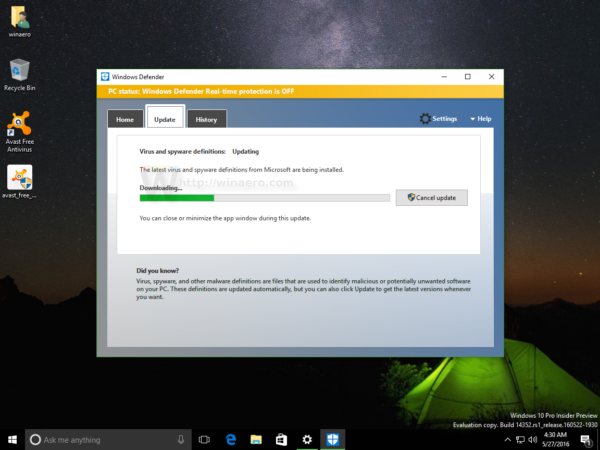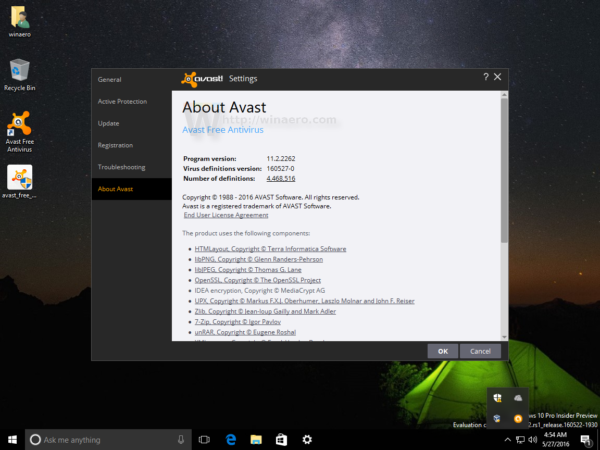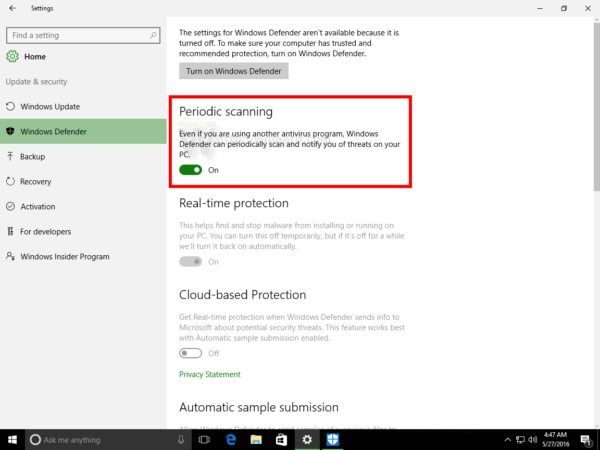Enable / disable Periodic Scanning feature on Windows 10
With Windows 10 build 14352, Microsoft provides and integrates a new security feature that will be available on the official Anniversary Update version. This feature is called Periodic Scanning. Periodic Scanning is an option of Windows Defender, which allows Defender to add other antivirus solutions.
Therefore, if you want users to install more programs, other antivirus software such as Avast, Kaspersky, Norton AntiVirus . to protect the system more safely.
When installing Windows 10, the operating system will automatically provide Windows Defender as an antivirus program. By default Windows Defender is enabled, and it is difficult to disable this program.
When installing Windows 10, the operating system will automatically select Windows Defender as the antivirus program for the system. By default Windows Defender is enabled, and it is difficult to disable this program.
In Settings => Update & security => settings, Windows Defender provides you with items to manage security options:

However, when users install other antivirus programs and software, Windows Defender will disable it automatically. All settings related to Windows Defender will be disabled and the Real-time protection option will change to Periodic Scanning :

Note that this new option only appears if Windows 10 can detect antivirus programs and software that you have installed, which means that antivirus programs must be compatible with Windows 10.
By default, Periodic Scanning is disabled. When enabled, Windows Defender will act as a virus scanner next to the main antivirus programs on your system. This will improve the security and safety of the system.
If Windows Defender detects threats, users will see a message appear on the screen.
When the Windows Defender application is disabled in the Periodic Scanning mode, the application's user interface is still active and the user can use it to view the update history, scan history and actions against threats. threatening.


1. Enable / disable Periodic Scanning feature on Windows 10
Suppose in this case you have installed the 3rd antivirus software. In the example below is Avast! Free.

1. Press the Windows + I key combination to open the Settings application on your Windows 10 computer.

2. On the Settings window, click on System - Update & security .

3. Next, select Windows Defender from the list of left frame options.
4. Enable Periodic Scanning on Windows 10 by activating Periodic Scanning option (switch the slider to ON):

If you want to disable Periodic Scanning on Windows 10, simply disable the Periodic Scanning option (switch the slider to OFF).

You can refer to the video tutorial of activation steps, disable Periodic Scanning feature on Windows 10 below:
Refer to some of the following articles:
- When and how to defragment hard drives on Windows 10?
- If you want to master Windows, master these shortcuts
- Clear the Windows 10 Update Cache to free up memory space
Good luck!
You should read it
- The periodic tables have the weirdest shapes in the world not everyone knows
- List of 26 bootable antivirus CDs for offline scanning
- How to scan viruses on Windows with Process Explorer
- Instructions for using Windows Defender
- Top 10 best antivirus websites, virus scanning online 2020
- Top 5 best online virus scanning software 2020
 Activate Credential Guard to enhance Windows 10 security
Activate Credential Guard to enhance Windows 10 security Displays the login information for the last time you log on to a Windows 10 computer
Displays the login information for the last time you log on to a Windows 10 computer Steps to disable or completely remove the Onedrive application on Windows 10
Steps to disable or completely remove the Onedrive application on Windows 10 Instructions to mount the hard drive into a folder on Windows 10
Instructions to mount the hard drive into a folder on Windows 10 How to run any application from the Ease of Access button on the Windows 10 login screen
How to run any application from the Ease of Access button on the Windows 10 login screen How to bring the Windows 8 search bar to Windows 10
How to bring the Windows 8 search bar to Windows 10